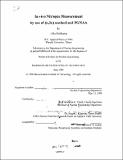In vivo nitrogen measurement by use of (n,2n) method and PGNAA
Author(s)
Ishikawa, Aiko, 1973-
DownloadFull printable version (14.11Mb)
Alternative title
In vivo nitrogen measurement by use of (n,2n) method and prompt gamma neutron activation analysis
Advisor
Jacquelyn C. Yanch.
Terms of use
Metadata
Show full item recordAbstract
The technique of in vivo neutron activation analysis has been used for the determination of various elements in the human body. There are two methods of measuring nitrogen in vivo: (n,2n) method and prompt gamma neutron activation analysis (PGNAA). The first method utilizes the fast neutron reaction 14 N(n,2n) 13N and the second uses the thermal reaction 14N(n,y)1 N. Both methods are currently in use at several different facilities for evaluation of the nutritional status of surgical patients or metabolic study of normal human subjects. In order for the absolute determination of nitrogen, it is necessary to obtain the uniform sensitivity of detection in the subject. Experimental factors which influence the sensitivity are the activating neutron flux and the absolute detector efficiency. The distribution of the two factors in the human body is dependent on the spectral characteristics of the neutron source, the geometries of irradiation and counting systems and the size of the subject. In this thesis investigations of sensitivity and absorbed dose of the two nitrogen methods are made based on the results of Monte Carlo simulation. Two experimental facilities utilizing the (n,2n) method and the PGNAA method are simulated to assess the suitability and the feasibility of in vivo measurement of nitrogen. The potential of the use of an electrostatic tandem accelerator as a neutron source for nitrogen measurement is examined by simulating hypothetical experimental set-ups. Furthermore, those results obtained by the simulation are verified by performing accuracy measurements by the (n,2n) method. The counting system designed for human thigh measurement is described. The (n,2n) method delivers about half of the equivalent dose of the PGNAA method with same irradiation time. The simulation results showed 10 - 20 times higher sensitivity for the (n,2n) method than the PGNAA technique, depending on the patient position for the irradiation. The simulation results for the accelerator sources presented higher sensitivity than the 238Pu-Be radionuclide source conventionally used.
Description
Thesis (S.M.)--Massachusetts Institute of Technology, Dept. of Nuclear Engineering, 1998. Includes bibliographical references (leaves 115-121).
Date issued
1998Department
Massachusetts Institute of Technology. Department of Nuclear Science and EngineeringPublisher
Massachusetts Institute of Technology
Keywords
Nuclear Engineering